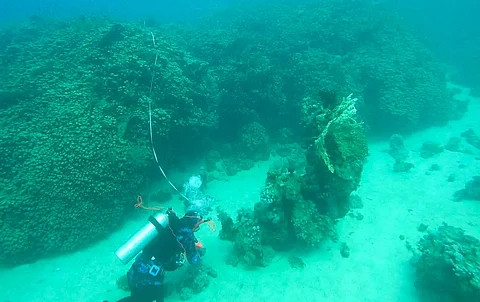

Red Sea Global (RSG) today announced the significant discovery of a giant coral colony in the Red Sea (of the Pavona species) within the waters of AMAALA on the northwestern coast of Saudi Arabia.
Rivalling the size of the current world record holder—a 32-by-34-meter colony found in the Pacific—this remarkable new find is the largest coral colony of this type documented in the Red Sea to date.
According to a press release issued by the RSG, this natural wonder could become a key highlight for tourists at AMAALA on diving excursions, offering a unique and unforgettable experience. Access would be permitted in line with RSG’s responsible tourism ethos, minimizing any potential impact while allowing visitors to witness the breathtaking beauty of the Red Sea’s underwater world.
RSG’s Head of Environmental Protection and Regeneration Ahmed Alansari said: “The discovery of a coral of such extraordinary dimensions demonstrates the ecological significance as well as the pristine beauty of the Red Sea.
At RSG, we believe it is critically important to protect our coral reefs. In particular, these giants represent a time capsule of information, providing the ideal tools for tracing past oceanographic transformations that can help us model responses to future environmental changes.
Understanding how this coral has survived for so long will be crucial for protecting other reefs in the Red Sea and potentially all over the world, for generations to come.”
The release added that determining the age of these giant corals with minimal impact is challenging due to the invasive nature of accurate dating techniques and the absence of published growth rates for this particular species of coral in the Red Sea.
However, estimations have been made based on the coral’s size, growth rates of this species found in the Pacific, and results from photogrammetry efforts. Using these tools, the coral cluster is estimated to be between 400 and 800 years old.
Upcoming studies by researchers from RSG and King Abdullah University of Science and Technology (KAUST) will help pinpoint the coral’s age more accurately and provide insights into the environmental conditions in which it has thrived.
Coral in the Red Sea is known for its particular resilience, adapting genetically to naturally warmer waters and higher salinity levels. This colony will be subject to ongoing monitoring and research to understand what makes these giants so resilient to multiple stressors over long time periods and to help inform conservation efforts for other reefs in the Red Sea and around the world.
The two RSG scientists who discovered the giant coral colony, Rhonda Suka and Sylvia Jagerroos, are now leading its mapping and documentation.
Suka said: “Finding such an invaluable specimen was a truly mind-boggling experience. This colony’s resilience gives us hope for the continued success of corals in the Red Sea, particularly in the face of increasing environmental and anthropogenic stress.”
